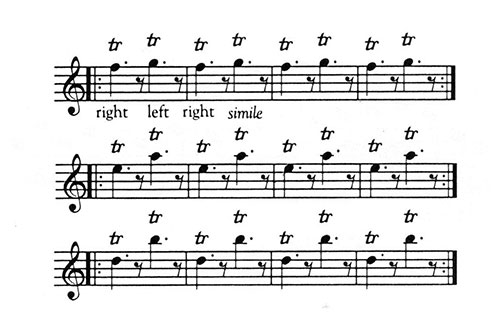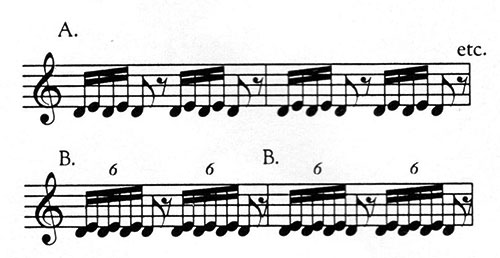A smooth, fluid finger technique relies on a good, relaxed hand position and a balance of tension between the hands. To feel that equal balance, hold the flute over your head with the keys parallel to the floor and finger high Eb. While counting slowly to 10, return the flute to a normal playing position. Although performers can’t raise the flute high during a performance, between movements they can stretch their arms out in front to feel the balance, then bring the flute back into playing position.
Another way to establish balance between the hands is to practice this trill exercise, which divides the flute length in half by starting in the middle of the flute between the G and F keys. Trilling at the bottom of the flute on low D might cause players to hold the flute with the right hand more than the left.

Play second-octave right-hand trills between F and G and left-hand trills between G and A. With the fingertips close to the keys, move the fingers lightly, quickly, and precisely from the hand knuckle, keeping the flute still. The fingertips should touch the keys in exactly the same spot each time. After approximately eight repetitions, proceed down the flute to trill E to F and up the flute to trill A to B. The last trills are between D and E and B and C.
Stand with the left foot about 10" in front of the right while practicing this exercise. During the right-hand trills shift the body weight over the right foot, and for left-hand trills place the body weight over the left foot for a more balanced feel.
Finger strength and coordination differs for each finger. The F finger is much stronger than the G finger, but with this exercise the strong finger will bring the weaker finger to a higher level of coordination. The E and A fingers are usually equal in strength, but the D finger is often less coordinated than the left-hand thumb. The exercise will develop equal strength and coordination for all fingers.
Articulate the beginning of each trill with the tip of the tongue and establish the first note well before proceeding to the second note. A strong puff of air will fill out the sound.
Another exercise that will train the fingers to move precisely is #17 in Big Daily Exercises by Taffanel and Gaubert. I play it in five-note chunks and repeat each chunk four times. Taffanel suggests trill fingering, but standard fingerings are a greater challenge.

Whole steps followed by a half steps make up the pattern, but Taffanel omits several of the intervals in the third octave. I ask students to maintain the pattern and include the missing intervals.
Students should practice these exercises each day in a three-day rotating schedule. Several finger combinations will challenge even advanced performers. When the five-note combination is going well, try the same notes in a seven-note pattern of two triplets. A metronome will keep track of progress and provide a feeling of accomplishment.
A three-octave, chromatic scale is the final test of excellent balance, and a tape recording will show any tone shifts that occur with changes of weight from the right hand to the left. The goal is to be smooth, legato, and balanced.





